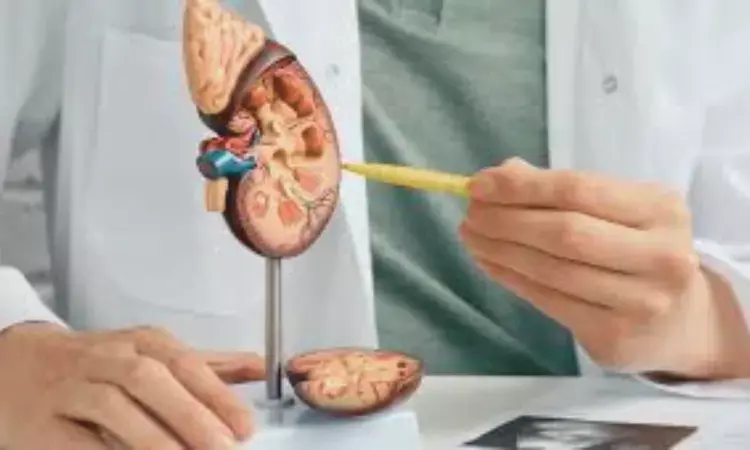- Home
- Medical news & Guidelines
- Anesthesiology
- Cardiology and CTVS
- Critical Care
- Dentistry
- Dermatology
- Diabetes and Endocrinology
- ENT
- Gastroenterology
- Medicine
- Nephrology
- Neurology
- Obstretics-Gynaecology
- Oncology
- Ophthalmology
- Orthopaedics
- Pediatrics-Neonatology
- Psychiatry
- Pulmonology
- Radiology
- Surgery
- Urology
- Laboratory Medicine
- Diet
- Nursing
- Paramedical
- Physiotherapy
- Health news
- Fact Check
- Bone Health Fact Check
- Brain Health Fact Check
- Cancer Related Fact Check
- Child Care Fact Check
- Dental and oral health fact check
- Diabetes and metabolic health fact check
- Diet and Nutrition Fact Check
- Eye and ENT Care Fact Check
- Fitness fact check
- Gut health fact check
- Heart health fact check
- Kidney health fact check
- Medical education fact check
- Men's health fact check
- Respiratory fact check
- Skin and hair care fact check
- Vaccine and Immunization fact check
- Women's health fact check
- AYUSH
- State News
- Andaman and Nicobar Islands
- Andhra Pradesh
- Arunachal Pradesh
- Assam
- Bihar
- Chandigarh
- Chattisgarh
- Dadra and Nagar Haveli
- Daman and Diu
- Delhi
- Goa
- Gujarat
- Haryana
- Himachal Pradesh
- Jammu & Kashmir
- Jharkhand
- Karnataka
- Kerala
- Ladakh
- Lakshadweep
- Madhya Pradesh
- Maharashtra
- Manipur
- Meghalaya
- Mizoram
- Nagaland
- Odisha
- Puducherry
- Punjab
- Rajasthan
- Sikkim
- Tamil Nadu
- Telangana
- Tripura
- Uttar Pradesh
- Uttrakhand
- West Bengal
- Medical Education
- Industry
TyG index associated with proteinuria and decreased renal function in primary membranous nephropathy: Study

A new study published in the journal of BMC Nephrology showed that in individuals with primary membranous nephropathy (PMN), the triglyceride-glucose (TyG) index is positively linearly correlated with severe proteinuria or reduced renal function.
This primary membranous nephropathy is brought on by autoantibodies attacking podocyte antigens, which results in the creation of in situ immune complexes. Nevertheless, 40% to 60% of individuals with nephrotic syndrome may eventually develop end-stage renal disease (ESRD) or pass away from cardiovascular events, and the pathophysiology of PMN is still not fully understood.
Fasting triglycerides (TG) and fasting blood glucose (FBG) are used to compute the triglyceride-glucose (TyG) index, which has been regarded as an easy-to-use and trustworthy proxy for insulin resistance (IR). Thus, Yue-Ming Gao and colleagues carried out this study to look into the relationship between the TyG index and severe proteinuria or impaired renal function in PMN patients.
A total of 536 individuals with PMN who were admitted to Peking University Third Hospital between January 2014 and December 2023 were recruited in this study sequentially. Ln[fasting triglyceride (mg/dL)×fasting blood glucose (mg/dL)/2] was used to compute the TyG index. The TyG index was used to classify each participant into quantiles.
Reduced renal function was defined as the estimated glomerular filtration rate < 90 mL/min/1.73 m2, and severe proteinuria was defined as 24 h urine protein > 3.5 g/d. Analysis was done using receiver operating characteristic (ROC) curves, restricted cubic spline (RCS) curves, and multivariable logistic regression.
Almost 355 individuals with severe proteinuria and 149 patients with reduced renal function were among the 536 patients with PMN. In PMN patients with severe proteinuria or impaired renal function, the TyG index values were noticeably higher. In patients with PMN, the RCS analysis showed a positive linear correlation between the TyG index and the probability of severe proteinuria or impaired renal function.
According to multivariate-adjusted logistic regression, individuals in the highest quantile of the TyG index were much more likely to experience severe proteinuria and impaired renal function, with the lowest quantile serving as the reference. The TyG index's area under the ROC curve (AUC) is 0.590 for reduced renal function and 0.613 for severe proteinuria.
Overall, severe proteinuria and impaired renal function are positively linearly correlated with the TyG score in PMN patients. The clinical use of the TyG index, a trustworthy surrogate measure of IR, to evaluate proteinuria or renal function in PMN patients is supported by this study.
Reference:
Gao, Y.-M., Wang, Z.-H., Deng, Z.-L., & Wang, Y. (2025). Higher triglyceride-glucose index is associated with severe proteinuria and decreased renal function in patients with primary membranous nephropathy. BMC Nephrology, 26(1), 114. https://doi.org/10.1186/s12882-025-04022-5
Neuroscience Masters graduate
Jacinthlyn Sylvia, a Neuroscience Master's graduate from Chennai has worked extensively in deciphering the neurobiology of cognition and motor control in aging. She also has spread-out exposure to Neurosurgery from her Bachelor’s. She is currently involved in active Neuro-Oncology research. She is an upcoming neuroscientist with a fiery passion for writing. Her news cover at Medical Dialogues feature recent discoveries and updates from the healthcare and biomedical research fields. She can be reached at editorial@medicaldialogues.in
Dr Kamal Kant Kohli-MBBS, DTCD- a chest specialist with more than 30 years of practice and a flair for writing clinical articles, Dr Kamal Kant Kohli joined Medical Dialogues as a Chief Editor of Medical News. Besides writing articles, as an editor, he proofreads and verifies all the medical content published on Medical Dialogues including those coming from journals, studies,medical conferences,guidelines etc. Email: drkohli@medicaldialogues.in. Contact no. 011-43720751


